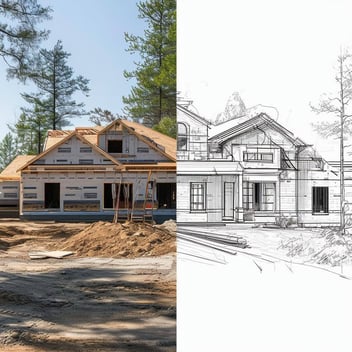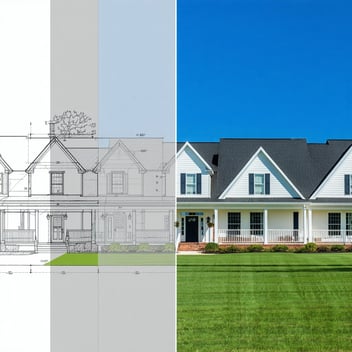3 Min Read
Understanding Kitchen Remodeling Costs in the Greater Minneapolis Area
Updated: 6/4/2025
Kitchens are often referred to as the "heart of the home." Remodeling your kitchen is an exciting opportunity to create a space that not only fits your lifestyle but also enhances your home’s value. From choosing the perfect layout to finalizing the smallest details, a kitchen remodel involves blending function, aesthetics, and personal taste. We’ll explore the essential aspects of a kitchen remodel in the Twin Cities—diving into the design elements that bring a kitchen to life.
Types of Kitchen Remodels and What They Cost
Kitchen remodels fall into three general categories, each with a different level of investment and transformation. Let’s walk through them.
1. Cosmetic Updates (Minor Remodel)
Estimated Cost: $50,000–$75,000
If your kitchen has good bones and a layout that works, a minor remodel may be all you need. Cosmetic updates focus on surface-level improvements that freshen up the look without altering the structure or layout. These projects are often DIY-friendly or can be tackled with the help of a handyman or smaller contractor. They’re a great option for homeowners looking to refresh their space on a budget—especially before selling.
What’s typically included:
-
Painting walls or cabinets
-
Replacing hardware (knobs, pulls, faucets)
-
Installing new countertops (laminate, butcher block, or entry-level quartz)
-
Updating light fixtures
-
Swapping out the sink or backsplash
Best for: Homeowners who want a visual refresh without major disruption.
2. Functional Upgrades (Mid-Range Remodel)
Estimated Cost: $75,000–$125,000
If your current kitchen doesn’t quite fit your lifestyle—maybe the flow is off or storage is lacking—a mid-range remodel could be the solution. These remodels focus on enhancing functionality while incorporating quality materials and modern design. Because this level often includes electrical, plumbing, or layout adjustments, you’ll likely need a licensed contractor and the appropriate permits.
What’s typically included:
-
Semi-custom cabinetry with better storage features
-
Quartz or granite countertops
-
Upgraded appliances (often energy-efficient)
-
New flooring (tile, hardwood, or luxury vinyl plank)
-
Partial layout reconfigurations (like removing a peninsula or expanding counter space)
Best for: Homeowners planning to stay in their home for several years and want a kitchen that works better for everyday use.
3. Transformational Changes (High-End Remodel)
Estimated Cost: $125,000–$200,000+
For homeowners who want a kitchen that’s personalized, luxurious, and truly custom, this is where design and craftsmanship shine. A high-end remodel involves a full transformation—often gutting the kitchen down to the studs and starting fresh.
What’s typically included:
-
Custom cabinetry with built-in organization systems
-
Luxury countertops like marble, quartzite, or waterfall islands
-
Structural changes (open floor plans, raising ceilings)
-
Professional-grade appliances (Sub-Zero, Wolf, Miele)
-
Custom range hoods and designer lighting
-
Integrated technology (smart lighting, hidden outlets, touchless faucets)
Best for: Homeowners who want to make a long-term investment in both lifestyle and home value.
What Factors Influence Kitchen Remodeling Costs?
The final price tag of your remodel depends on several variables. Here’s what can push your budget up—or help keep it in check:
1. Layout Changes
Moving plumbing, gas lines, or load-bearing walls increases both labor and permit costs. Keeping your sink, appliances, and range in the same place can reduce expenses.
2. Cabinetry
Cabinets typically make up the largest portion of a kitchen remodel budget. Choosing between stock, semi-custom, or fully custom cabinetry will have a major impact on cost and lead time.
3. Appliances
The difference between a $1,200 range and a $10,000 professional model adds up quickly—especially when you factor in built-in refrigeration, panel-ready finishes, and specialty appliances.
4. Material Selections
Finishes like natural stone, artisan tile, or wide-plank hardwood floors can elevate your kitchen—but they’ll also elevate your budget. Many homeowners blend splurges and saves to stay balanced.
5. The Home’s Age
Older homes in Minneapolis and Edina often need updated wiring, plumbing, insulation, or flooring once walls are opened up. These “hidden costs” can’t always be predicted but are common.
Budgeting Tips for Your Kitchen Remodel
Set Your Priorities:
Know where you want to invest (e.g., cabinetry, appliances) and where you’re willing to save.
Plan for Contingencies:
Set aside 10–15% for unexpected issues—especially in older homes.
Work With a Design-Build Team:
This helps streamline planning, design, pricing, and execution—keeping your remodel on time and on budget.
Bring Your Dream Kitchen to Life
A kitchen remodel is one of the most impactful investments you can make in your home. Beyond improving function and style, it’s an opportunity to create a space that truly supports how you live—whether that means more room to cook, entertain, or simply gather with family. With thoughtful planning, clear priorities, and a realistic understanding of costs, you can transform your kitchen into a space that feels both timeless and uniquely your own.





